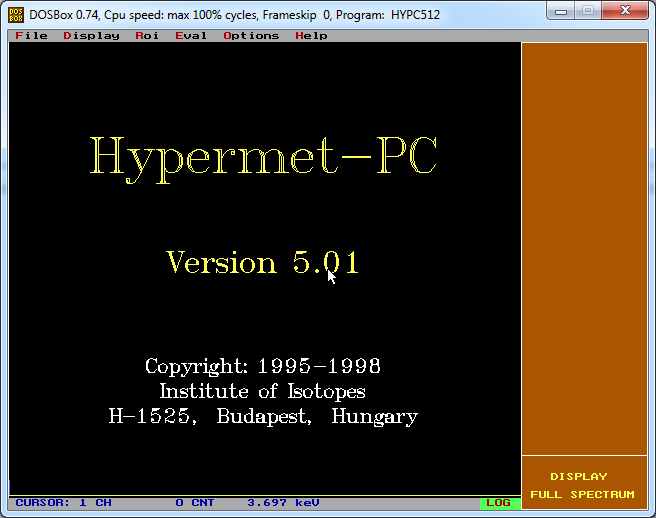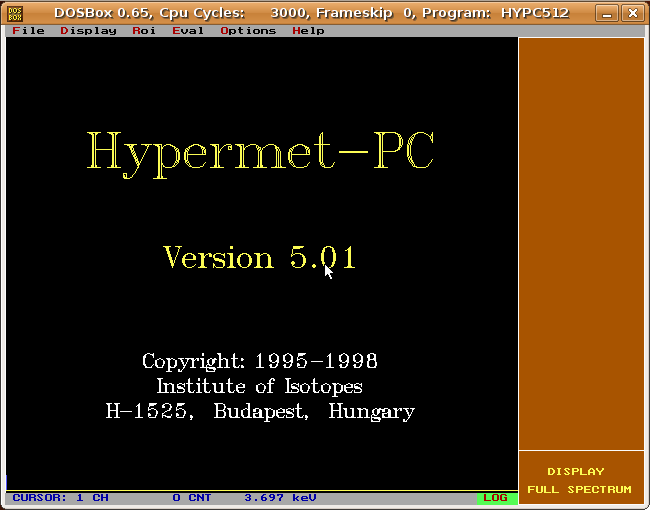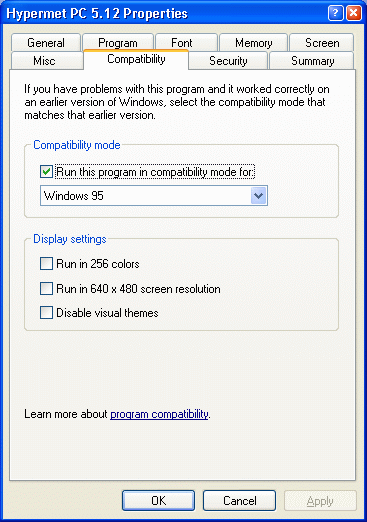Hypermet-PC - Compatibility tips
Introduction
Feature list
Compatibility tips
Downloads
Customer care
System
requirements
- Hardware requirements:
- 386 or better CPU,
- mathematical co-processor,
- 2 MB RAM,
- about 3 MB free hard disk space for Hypermet-PC,
- and another 2 MB when the program is running,
- standard VGA video card (640x480 resolution, 16 colors) or better,
- mouse,
- CD-ROM
or 3,5" floppy drive for the installation.
- Supported operating systems:
- MS-DOS 6.x
- MS Windows 3.x
- Windows 95/98/98SE/Me system
- Windows
XP (with Windows-95 compatibility option enabled, see below)
Converter utility for Canberra's CAM format
A free utility is offered to convert Canberra's CAM files (*.cnf) to their earlier file format, S100 (*.mca). This latter can be loaded into Hypermet-PC properly. The conversion preserves the calibration and most of the header data. More
Troubleshooting
for Windows Vista, Windows 7, 8, 10, Mac and Linux Users
Hypermet-PC can be executed on these modern operating systems using a DOS emulator called DOSBOX.
- Download and install DOSBOX from http://www.dosbox.com/. Windows and Linux versions were successfully tested. Mac version also works, but the graphics seems to be very slow.
- Install Hypermet-PC to a directory without special characters, accented letters and spaces. Good examples are C:\HYPC, C:\Programs\HYPC
- Edit the configuration file of DOSBOX as follows: open Start Menu -> All Programs -> DOSBox-0.74->Options->DOSBox 0.74 options. This opens a Notepad with dosbox-0.74.conf file. Scroll down to the end of the file.
- Add mount command to access each of your drives. In linux, full path of a directory shall be given such as /home/username/spectra. Modify the TEMP and Hypc exe paths to match your system setup. [autoexec]
- Save the file and close Notepad.
- Start DOSBox from Start Menu. It should open Hypermet automatically
- Tip: to get rid of the Status Window in the background, add the -noconsole option to the DOSBox shortcut's command line
# Lines in this section will be run at startup.
# You can put your MOUNT lines here.
mount c: c:\
mount d: d:\
...
SET TEMP=c:\windows\TEMP
c:\hypc\hypc512.exe
exit


Troubleshooting
for Windows XP Users
- If you intend to use Hypermet-PC on a Windows XP system, we encourage you to apply the Windows-95 compatibility option. Please select HYPC.EXE or the corresponding PIF File, click on it with right mouse button, choose Properties. On the Property page, select the Compatibility tab, and enable "Run this program in compatibility mode for:" option, as shown in the figure.

- The following tip is based on Troubleshooting MS-DOS-Based Programs in Windows (Q314106) at Microsoft Knowledge Base website.One of the first thing to test when you are having problems with MS-DOS-based programs is the Windows Virtual DOS Machine (NTVDM) subsystem. Open START menu, choose option RUN and enter command.com or cmd.exe. If you don't see a MS-DOS windows coming up, you of course have a problem.
Config.nt
dos=high, umb
device=%SystemRoot%\System32\Himem.sys
files=20
Autoexec.nt
lh
%SystemRoot%\System32\Mscdexnt.exe
lh
%SystemRoot%\System32\Redir
lh
%SystemRoot%\System32\Dosx
lh
%SystemRoot%\System32\Nw16 (only if CSNW is installed)
lh
%SystemRoot%\System32\Vwipxspx (only if CSNW is installed)
The registry entries that are associated with the NTVDM subsystem are:
HKEY_LOCAL_MACHINE\System\CurrentControlSet\Control\Session Manager\Environment
This key stores the environment variables from the Config.sys and Autoexec.bat files for use in Windows.
HKEY_LOCAL_MACHINE\System\CurrentControlSet\Control\ VirtualDeviceDrivers
This key stores the device drivers that are used in an NTVDM session. Windows Setup creates these entries when a device driver is installed.
Please read the complete article for further details.

